New unitary authority not going to plan
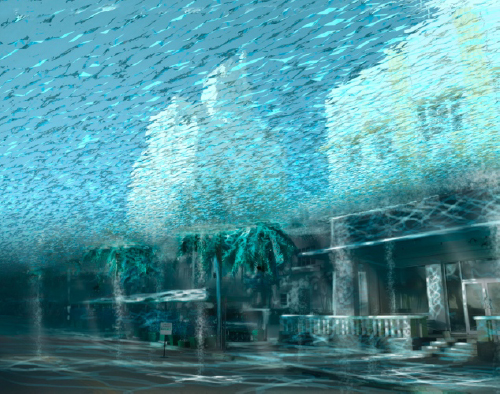
Seven-Metres-High and Rising: South Beach, Miami has otherwise enjoyed fame as an exemplar of attractive but compact low-rise development, but here it is receiving attention as the face of the 25-foot sea-level rise possible this century. While only small areas of Auckland, such as Ōrewa, are quite as low-lying as South Beach, the long-term geography of the region will be better described as archipelago than as isthmus. artist Nickolay Lamm
Len’s in danger of loosing it.
As was all too apparent halfway through the term of Aotearoa’s first mayoral office to enjoy significant executive powers, Mayor Brown has bet the farm on a project for which he has little to show, come local body election year.
Had Labour not been humiliated in the 2011 national election, and had that party broken the habit of a lifetime and supported a bold transport plan for the country’s real capital, Mayor Len Brown might today be presiding over an unstoppable $3 billion city rail link project. Instead, with the re-election of a government led by the steadfastly rail-averse National Party, many were left with no confidence that construction of the rail link will begin anytime soon, or were unconvinced that rail, as opposed to buses and busways, would service the needs of sufficient Aucklanders.
Meantime, the gargantuan task of combining the legacy town planning instruments of seven city or district councils and one regional authority in the inaugural term of the new unitary authority was always going to be hugely fraught. In truth, the overnight restructuring of the region should never have been attempted, but the Royal Commission on Auckland Governance couldn’t resist playing god—there were more robust and less disruptive means by which the governance of the region could have been rationalised. One of the world’s leading experts on the subject, and on local authority governance on both sides of the Tasman Sea, was not even invited to travel from Queensland to assist the commission. In addition to the considerable disquiet about the centralised powers of the new unitary authority, and the unfounded fear that the entire region is doomed to become urban, the perception has emerged of a plan imposing high-rise development on once leafy boroughs.
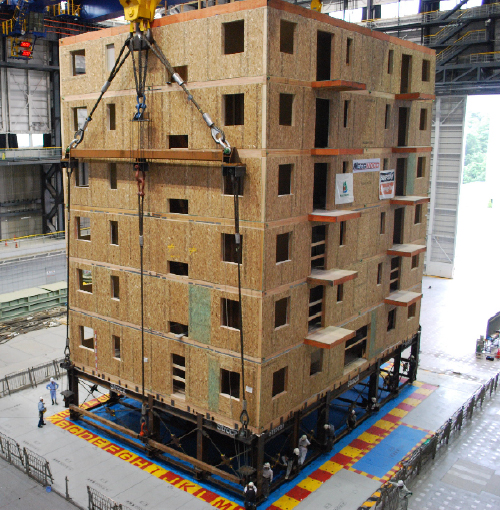
Playing to Forestry’s Strength: Factory-build mid-rise apartments capable of being transported to site, but also to higher ground, and, unlike concrete and steel buildings, actually serve to store carbon—collectively cement and steel production is responsible for more than 10% of carbon dioxide emissions globally. Here a six-story condominium is about to be subjected to simulated earthquakes, leading up to a simulated magnitude 7.5 quake, on Japan’s E-Defense shake table—the only damage sustained was to some of its gypsum board. image Simpson Strong-Tie
A hundred years ago to the month, one of Aotearoa’s most fruitful ever royal commissions reported. It was on forestry, and the outcome was the planting of more than 300 000 hectares, by 1935. By 1984 the magic million milestone had been reached, but in 2011, although the total was 1.7 million, the area in planted forest had dropped back by 18 600 hectares from the previous year, at the crucial time for more carbon to be locked up, rather than less. Tragically, through a combination of sometimes inappropriate harvesting methods and disregard for remnant or regrowth indigenous forest, townsfolk now generally have a jaundiced view of an industry that should be the darling of conservationists in general and climate activists in particular. It is also a fact that the royal commission did a spectacular disservice to planted indigenous forestry, in its totally erroneous view that the likes of tōtara and pūriri would have taken centuries to grow to marketable size. Be that as it may, future historians will marvel that a 2013 unitary plan promoted high-rise construction, effectively mandating about the most egregious greenhouse-gas-intensive materials possible—concrete and steel:
Every time you see a wood building, it’s a storehouse of carbon from the forest. When you see steel or concrete, you’re seeing the emissions of carbon dioxide that had to go into the atmosphere for those structures to go up.
The reaction, some might say overreaction, of Aucklanders to the emphasis on high-rise building was predictable, and avoidable. Using mostly low-rise buildings of two to four stories, South Beach, Miami –style, the region’s population, including the extra million being allowed for over the next 30 years, could be comfortably contained within an area 20 kilometres in diameter—or about twice the averaged diameter of Hamilton. Designed from scratch to favour walking and cycling, such a city could comfortably be cycled from city centre to its green belt in half an hour.
While South Beach may be the poster child for human-scale development, Florida faces monstrous infrastructure spending in the face of sea-level rise. The low-lying Makaurau isthmus could be considered Aotearoa’s Florida. Much the industrial and commercial area of Manukau suggested for brown-fields development by aspiring centre-right mayoral candidate John Palino is a mere 20 metres above sea level. The timeframe for Manukau’s inundation is unknowable because it depends upon how long business-as-usual prevails, and that depends upon global political decisions and the efficacy of resultant emission reduction policies. For all the talk before, during and after Kyoto, fossil fuel use is continuing to grow. Slowing sea-level rise would require massive reductions in emissions—not simply holding emissions at anything like their present levels. One of two things would need to happen before political decisions favouring decisive climate action could occur. Either control of the political process would have to be wrested from the hands of big business, or big business must suddenly and uncharacteristically become convinced that its long-term interests are more important than its short-term profits.

What If We Never Run Out of Oil: In addition to the ruinous quantities of unconventional petroleum—tar sands, tight oil, heavy oil, shale gas, coal-bed methane, shale oil, oil shale—that have come online, methane clathrate hydrate is possibly twice as abundant as all other fossil fuels combined. Here, yellow squares indicate where clathrates have already been recovered, and the blue dots are where they are thought to exist. map Alice Cho
As though anticipating the effect of future policy wasn’t already difficult enough, the world is discovering that fossil fuels are the gift (or curse) that keep on giving, including from an emergent class of greenhouse gas emitting fuel, methane clathrate hydrate:
Stored mostly in broad, shallow layers on continental margins, methane hydrate exists in immense quantities; by some estimates, it is twice as abundant as all other fossil fuels combined.
Japan is probably furthest advanced towards the commercial abstraction of methane clathrates. The country, which has no oil fields of its own, has immense reserves, as does Aotearoa. Thanks to media obsession with the tsunami-damaged Fukushima 1 Nuclear Power Station, which killed no one, as opposed to the Tōhoku Tsunami itself, which directly slaughtered nearly 20 000 media-forgotten souls, Japan is now doubly dependant on coal imports to generate its electricity—it is the largest coal importer after China. Methane might be much cleaner burning than coal, and produce only half as much carbon dioxide, but if the enormous reserves in clathrate form are accessed it is likely to guarantee that renewable energy technologies have an even harder job of replacing fossil fuels.
Rebuilding a city levelled by earthquakes at near sea level represents an appalling waste of opportunity, but at least the traumatised Christchurch residents and their rattled leaders have some excuse for their tunnel, or cathedral, vision. Their fellow countrymen, however, are affording them no kindness by failing to challenge the misspending of $40 billion in rebuilding funds, when the exercise will have to be repeated, possibly within a century. But equally, Auckland Council, by planning to accommodate a million more people in the next thirty years on the mostly on its low-lying isthmus and hinterland is doing future Aucklanders no favours. Over time, the city could conceivably save itself a trillion dollars by bowing to the inevitable sooner rather than later and begin planning for an early and orderly transition that destroys no more wealth, private or public, than is absolutely necessary. With it would come a colossal marketing advantage in being, unassailably, the world’s leading climate-transition city.
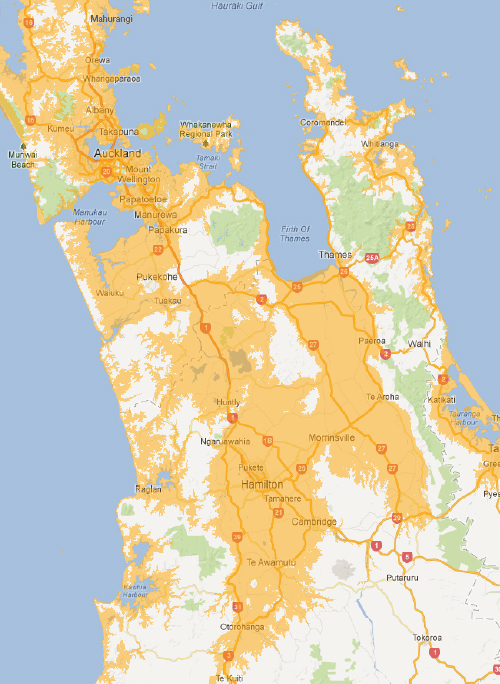
Sea-Level Rise Starts at 2100: Focussing on the end of the century has blinded decision makers to the fact that sea-level rise will by then be accelerating rapidly, if not decades before. Business-as-usual fossil fuel use suggests a premature end to the Pleistocene glaciation and the oceans back at their more usual 80-metre-higher level. map Hey What’s That
The first question to be addressed is location. Admittedly Mangere’s proposed new runway would be about 10 metres higher than the existing, but by the end of this century that margin is likely looking distinctly shortsighted, and the motorway connecting in to the central business district will definitely be underwater, at its current elevation. Suitable locations to house 2.5 million safe from long-term sea-level rise depend both upon development density. The range of densities proposed in the draft unitary plan would allow Auckland to decamp to the Bombay Hills, to the east of the market-garden land, which along with the Hunua Ranges, long term, is fated to become an island about two thirds the area of Hong Kong. But there it would be isolated from the rest of the North Island by road or rail, unless a 60-kilometre series of causeways were constructed to just south of Morrinsville. Construction costs would also be high, given the hilly terrain, which would also work against it easily being developed to favour walking and cycling.
To find flat land of an area suitable for a city south of the Bombay Hills would be a 25-minute high-speed-rail ride from the current central business district, just south of Matamata—the Kentucky of Aotearoa. If the rail connected through to Rotorua, it would also form a valuable tourist conduit. Given that short-haul flights burn nine times as much carbon dioxide per passenger per kilometre travelled than high-speed rail, a modern Auckland–Rotorua line should long have been a clean–green prerequisite. The availability of high-speed rail might in turn recommend that Auckland Airport’s next big expansion be on the volcanic plateau.
While a southern Makaurau might be more logical, the Bombay Hills location is a more immediate area for large-scale intensive low-rise development, and it could readily be serviced by an electrified busway. Many of the Aucklanders repulsed by the spectre of high-rise, would nevertheless vote with their mortgages to live in apartments from which they could watch their children and grandchildren playing in the park, and from where they could call them home for dinner without recourse to a cell phone, as so poignantly documented by Adam McNaughton in his Jeely Piece Song, a.k.a Skyscraper Wean:
Oh ye cannae fling pieces [jelly sandwiches] oot a twenty-story flat
The draft unitary plan literally epitomises the old admonishment that those who have dug themselves into a hole should stop digging. The tracks at the city’s rail terminus, Britomart, are already 10 metres below sea level and the station’s designers only allowed for a half-metre of sea-level rise by 2100. This allowance has already been more than doubled, but some climate scientists, notably Dr James Hansen and Dr Makiko Sato, 2011, warn:
Sea level rise, despite its potential importance, is one of the least well understood impacts of human-made climate change. The difficulty stems from the fact that ice sheet disintegration is a complex non-linear phenomenon that is inherently difficult to simulate, as well as from the absence of a good paleoclimate analogue for the rapidly increasing human-made climate forcing.
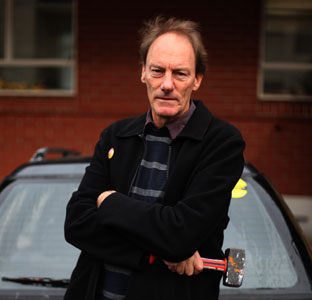
Evening-Up the Contest: With John Minto likely to bleed votes away from the left-leaning incumbent mayor, right-leaning John Palino could potentially have the same effect on Maurice Williamson, should he stand. Sadly the Royal Commission on Auckland Governance let the region down by opting for the first-past-the-post status quo, which is particularly adept at failing to divine the preference of voters. In 2010 Minto threatened to damage gambling machines to even up the odds for their victims. photographer Sylvie Whinray
The region’s singular public transport success story, since the fateful 1950s decision to sacrifice trams to Aucklanders’ boundless enthusiasm for the automobile, has been the Northern Busway. By now it should extend to Ōrewa. Instead, work has only just begun on the Silverdale park and ride. But bus transport, over the region, has a long way to go before it patrons consistently feel that they are not second-class citizens to the solo car driver. The Swiss, since the early 1980s, have operated a consummately efficient means of adjusting the phase and timing of Zurich’s traffic signals to provide priority for buses and trams. More recent implementations are global-positioning-system-based and are possibly, in some respects, inferior to the Zurich’s technology, but they can still reduce delays in public transport by up to 40%. A refinement used in Stockholm avoids giving priority to buses that are running ahead of schedule, to avoid clumping at bus stops. If the odd motorist resents buses receiving priority, such motorist needs politely reminding that each bus receiving priority may be responsible for some 70 fewer cars on the road.
Then there’s cycling. The $10 million or more spent by the council planning for the city rail link and by the government in opposing it, could by now have transformed city cycling, and a cycleway (or Shweeb) could have been slung under the harbour bridge. Instead, cyclists go into an election angry about gauntlet they are caused to run daily. And short of the absolute precaution of directing major new development above the 80-metre contour, Auckland could provide a home for the largely surplus-to-government-requirements technology pioneered at the University of Canterbury for constructing post-tensioned earthquake-proof wooden buildings, and manufacture them in modular form to provide for future relocation and/or reconfiguration—merely forgoing the obligatory steel-reinforced concrete slab flooring would be a useful start.
Had Mayor Len Brown got new busways and busway extensions well underway, and had he presided over a unitary plan that Aucklanders could immediately warm too, and had he articulated a bold vision for a world-leading transition to a climate-savvy city, he would now be less seriously threatened from left and right. In the last election, against an even then not particularly popular John Banks, Len Brown garnered slightly fewer than half the votes cast. John Minto has the profile to capitalise on the curse-on-both-your-houses resentment with the amalgamation process, and disgust at the pokies-for-convention-centre deal—damned by Deputy Auditor-General Phillippa Smith—in particular. Sadly, unless Brown rocks the city by backing Minto, Aucklanders risk having a candidate with minority support, Maurice Williamson, Minister for Building and Construction, Customs, Statistics, and Land Information, elected with the support of a little as 20% of eligible voters—thanks to systemically low voter turnout, and the lack of preference voting—the latter thanks to the studied ignorance of the royal commissioners.
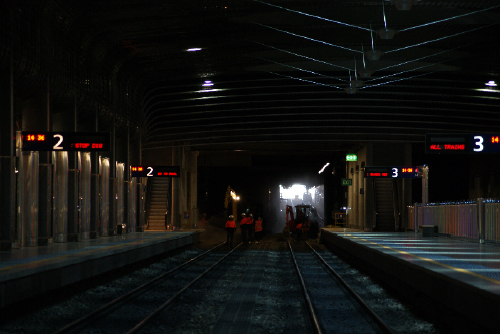
Stop Digging: Lulled into of false sense of security by Intergovernmental Panel on Climate Change projections that excluded glacier and ice-sheet melt, planners have typically allowed for only a fraction of the multi-metre sea-level rise likely by 2100. With so much of its infrastructure already at or below sea level, Auckland is condemned to spend staggering amounts on adaptation, without wantonly compounding the problem. image Campaign for Better Transport
If Maurice Williamson, the unlikely new darling of gays and their supporters, and proxy for the myopic motorway-obsessed National Party, was to secure the mayoral chains, it would surely burnish the prospects for a third privatise-everything-and-don’t-spare-the-horsepower National term. And New Zealanders of conscience would be obliged to endure three more years of living the clean–green lie.
Atmospheric carbon dioxide is nudging 400 parts per million, a 43% increase since the beginning of the Industrial Revolution. In the past, with far less precipitous rises in carbon dioxide, multi-metre sea-level rise has occurred over just decades. An all-new unitary authority presiding over an isthmus fated to become an archipelago could have been expected to epitomise the need to plan for climate mobilisation. It’s not too late for Mayor Len Brown to show he is capable of listening and fast track more busway construction, and present a vision for compact low-rise development, sufficiently above sea level, that would both better appeal to Aucklanders and avoid forbidding cliffs of concrete, steel and glass. He could demonstrate that the draft unitary plan is not a draft in name only.
The good news about non-linear sea-level rise is that the first metre will be slow coming. This makes it all the more imperative that meaningful planning for multi-metre sea-level rise begins immediately, so that the wriggle room is not squandered constructing high-rise and infrastructure where, or in a manner that, inundation will render it largely unsalvageable. What is urgent is inducing many more Aucklanders to commute by bus, bike and by fibre. Further, the pressure to reside in the region would be enormously lessened if every town and every farmhouse had fibre to the desktop—let the start-ups remain and prosper ‘in the regions’, rather than add to the pressure to migrate to obscenely overpriced premises in all-too-soon-to-be flood zones.
If an all-new unitary authority is not going to plan for the future that is forecast, Aucklanders are no better served than by the old, fragmented structure.
